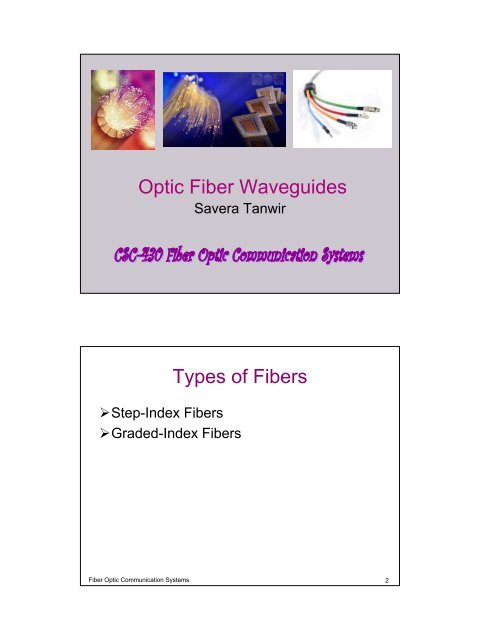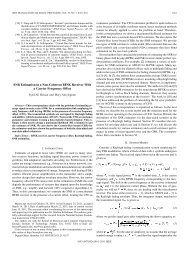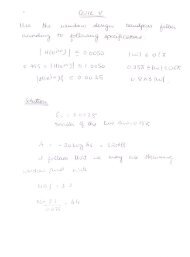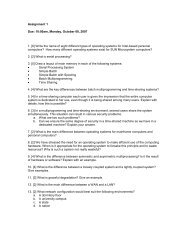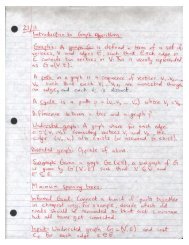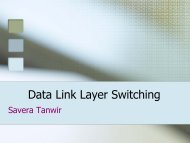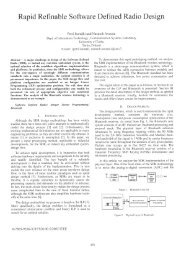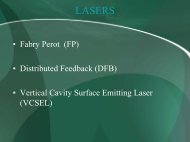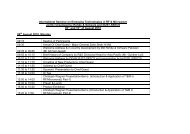Optic Fiber Waveguides Types of Fibers - Contact Information
Optic Fiber Waveguides Types of Fibers - Contact Information
Optic Fiber Waveguides Types of Fibers - Contact Information
You also want an ePaper? Increase the reach of your titles
YUMPU automatically turns print PDFs into web optimized ePapers that Google loves.
<strong>Optic</strong> <strong>Fiber</strong> <strong>Waveguides</strong>Savera Tanwir<strong>Types</strong> <strong>of</strong> <strong>Fiber</strong>s‣Step-Index <strong>Fiber</strong>s‣Graded-Index <strong>Fiber</strong>s<strong>Fiber</strong> <strong>Optic</strong> Communication Systems 2
Step-Index <strong>Fiber</strong>‣ SI fiber consists <strong>of</strong> a central core with refractive index n 1 ,surrounded by a cladding with refractive index n 2‣ The critical angle for SI fiber is given bysinθ c = n 2 /n 1‣ Fractional Refractive Index Change∆ = (n 1 – n 2 )/n 1 n1 is typically between1.44 and 1.46 ∆ is always positive since n1is larger than n2 for a critical angle to existcladdingcoreθn 2n 1claddingcore<strong>Fiber</strong> <strong>Optic</strong> Communication Systems 3Step-Index <strong>Fiber</strong>‣Why do we need cladding?– Air satisfies the condition n 1 > n 2– <strong>Fiber</strong> can easily bend or get scratched,causing losses– Cladding protects the core from contaminationand helps preserve its physical integrity<strong>Fiber</strong> <strong>Optic</strong> Communication Systems 4
‣ FormsStep-Index <strong>Fiber</strong>– A glass core cladded with glass– A glass core cladded with plastic– A plastic core cladded with plastic– The refractive index step is smallest for all-glassfibers and largest for all-plastic fibersThis is because <strong>of</strong> the small range <strong>of</strong> refractive indicesavailable in glasses and a large range in plasticsNA = n o sin α o = sqrt ( n 12 –n 22 )= n 1 sqrt (2∆)<strong>Fiber</strong> <strong>Optic</strong> Communication Systems 5Properties <strong>of</strong> SI <strong>Fiber</strong>s– The NA and pulse spread are smallest for all-glassfibers and highest for all-plastic fibers– <strong>Fiber</strong>s with little pulse spread have large rate-lengthproducts. The NA <strong>of</strong> these fibers is small making itdifficult to couple light in them– All-glass fibers have the lowest losses and smallestpulse spreadingUseful at moderately high information rates and for fairly longlengths. Coupling from light source is difficult due to small NA<strong>Fiber</strong> <strong>Optic</strong> Communication Systems 6
Properties <strong>of</strong> SI <strong>Fiber</strong>s‣ PCS (Plastic cladded silica) fibers have higher lossesand large pulse spreads they are used for shorter links– Their higher numerical apertures increase the source couplingefficiency, but this advantage is lost in long fibers due toincreased absorption‣ All plastic fibers are limited to very short paths by theirhigh propagation losses.– Path lengths are usually less than a few tens <strong>of</strong> meters– Large acceptance angles improve coupling efficiency<strong>Fiber</strong> <strong>Optic</strong> Communication Systems 7Properties <strong>of</strong> SI <strong>Fiber</strong>s‣ Light can also be trapped in cladding if its refractiveindex is greater than the material surrounding it‣ It happens because some light rays are introduced intothe fiber at angles beyond the acceptance angle‣ Also at discontinuities like splices and connectors, wherelight may be detected beyond the core node anglesn on 2n 1claddingcore<strong>Fiber</strong> <strong>Optic</strong> Communication Systems 8
Properties <strong>of</strong> SI <strong>Fiber</strong>s‣ The light traveling in the cladding modeattenuates more quickly than light in core– Outer boundary <strong>of</strong> the cladding is in contact with alossy medium– The power attenuates so rapidly that the claddingmodes are in significant at the end <strong>of</strong> a long fiber<strong>Fiber</strong> <strong>Optic</strong> Communication Systems 9Example‣Suppose the all-glass fiber is surroundedby air. Compute the critical angle at thecladding-air boundary<strong>Fiber</strong> <strong>Optic</strong> Communication Systems 10
Graded-Index <strong>Fiber</strong>‣ A GRIN fiber has a core material whose refractive indexdecreases continuously with distance from the fiber axisn(r) = n 1 .sqrt(1 – 2(r/a) α ∆)n(r) = n 1 .sqrt(1 –2∆) = n 2r ≤ ar > aWheren 1= refractive index along the fiber axisn 2= refractive index <strong>of</strong> the claddinga = core radiusα = refractive index pr<strong>of</strong>ile variation∆ = parameter determining the scale <strong>of</strong> pr<strong>of</strong>ile change<strong>Fiber</strong> <strong>Optic</strong> Communication Systems 11Graded-Index <strong>Fiber</strong>‣ Changing RI continually redirects the rays towards thefiber axis‣ This can be modeled using series <strong>of</strong> small steps (changein RI)<strong>Fiber</strong> <strong>Optic</strong> Communication Systems 12
Graded-Index <strong>Fiber</strong>‣The most common refractive index pr<strong>of</strong>ilefor a graded index fiber is very nearlyparabolic‣The parabolic pr<strong>of</strong>ile results in continualrefocusing <strong>of</strong> the rays in the core<strong>Fiber</strong> <strong>Optic</strong> Communication Systems 13GRIN Acceptance AngleEscaping Ray2α 0Trapped Ray2α 0NA = n 1 (2∆) ½ (1 – (r/a) 2 ) ½<strong>Fiber</strong> <strong>Optic</strong> Communication Systems 14
Advantages <strong>of</strong> SI‣ The advantages <strong>of</strong> a step-index multimode fiber arerelated to the relatively large core area and highnumerical apertures. Both <strong>of</strong> these properties allow lightto be easily coupled into the fiber.‣ In turn, this allows the use <strong>of</strong> inexpensive terminationtechniques, low cost diodes, and high power handlingcapability.‣ These fibers are therefore widely short distance datacommunications, and fiber sensors.<strong>Fiber</strong> <strong>Optic</strong> Communication Systems 15Disadvantages <strong>of</strong> SI‣ A disadvantage to step-index multimode is bandwidth.‣ The path the light takes down a step-index multimodefiber will be longer or shorter depending on the angle <strong>of</strong>propagation. This difference in path length causes thepulse <strong>of</strong> light to spread out during its journey down thefiber.‣ This is known as modal dispersion<strong>Fiber</strong> <strong>Optic</strong> Communication Systems 16
Advantages <strong>of</strong> GRIN‣ The graded pr<strong>of</strong>ile and smaller core increases bandwidthover step-index fibers, but the core sizes are still largeenough for convenient termination and use <strong>of</strong> lower costdiodes.‣ These are used in medium to long distancecommunications‣ Low pulse distortion<strong>Fiber</strong> <strong>Optic</strong> Communication Systems 17Attenuation‣ Attenuation is the reduction in amplitude andintensity <strong>of</strong> a signal‣ The attenuation <strong>of</strong> an optical fiber measures theamount <strong>of</strong> light lost between input and output‣ Receivers require some minimum power level,to accurately detect the transmitted signal<strong>Fiber</strong> <strong>Optic</strong> Communication Systems 18
Attenuation‣ Losses occur at the channel coupler, splices,connectors and within the fiber itself‣ These transmission losses limit path length‣ Requirements for fiber material–Low loss– Ability to formed into hairlike long strands– Capable <strong>of</strong> slight variations to achieve different RIs– Continuous change in RI for Graded Index <strong>Fiber</strong><strong>Fiber</strong> <strong>Optic</strong> Communication Systems 19Glass - Attenuation‣ Glass fibers have low absorption than plasticfibers‣ Glass fibers are preferred for long haulcommunications‣ Glass in formed by fusing molecules <strong>of</strong> silica(silicon dioxide SiO 2 ) and other material(titanium, thallium, germanium, boron etc.)<strong>Fiber</strong> <strong>Optic</strong> Communication Systems 20
Glass - Attenuation‣Objective: manufacture low-loss fiber‣Attenuation in Glass fiber– Absorption– Scattering– Geometric Effects<strong>Fiber</strong> <strong>Optic</strong> Communication Systems 21‣Intrinsic Absorption:Absorption– Glass absorbs heavily within specific wavelengthregions– A natural property <strong>of</strong> glass– It is very strong in the short-wavelength ultravioletportion– Peak lossUltraviolet region butunimportant<strong>Fiber</strong> <strong>Optic</strong> Communication Systems 22
Absorption‣ Intrinsic absorption peak also occur between 7 and 12µm in the infrared‣ Infrared loss is associated with vibration <strong>of</strong> chemicalbonds‣ Intrinsic losses are most significant in wide region wherefiber systems can operate– Intrinsic losses restrict the extension <strong>of</strong> fiber systems toward theultraviolet as well as toward longer wavelengths– <strong>Fiber</strong> <strong>Optic</strong> Comm operates in a range <strong>of</strong> wavelengths from 0.5to 1.6 µm<strong>Fiber</strong> <strong>Optic</strong> Communication Systems 23Impurities‣Impurities are major source <strong>of</strong> loss inpractical fiber‣<strong>Types</strong> <strong>of</strong> impurities– Transition-metal ions– OH ions<strong>Fiber</strong> <strong>Optic</strong> Communication Systems 24


